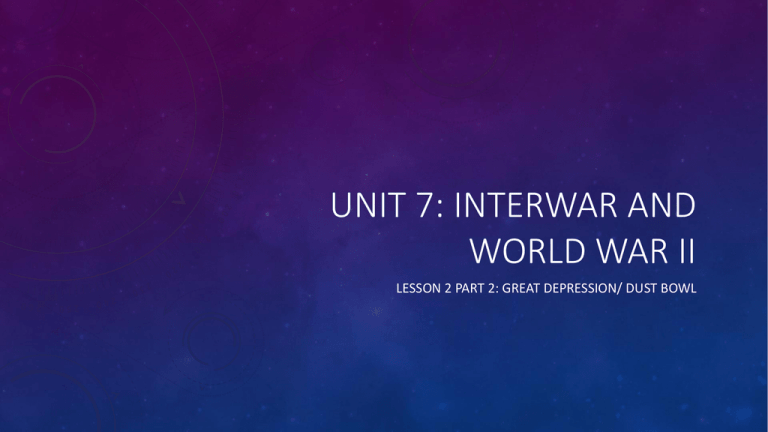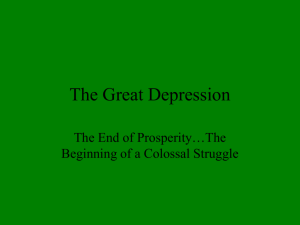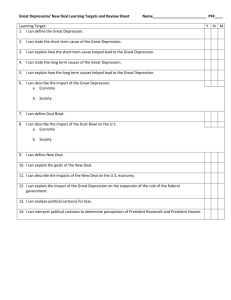Unit 7 lesson 2 part 2
advertisement

UNIT 7: INTERWAR AND WORLD WAR II LESSON 2 PART 2: GREAT DEPRESSION/ DUST BOWL WHAT I NEED TO KNOW • World War I and the Russian Revolution had a dramatic effect on the countries that were involved in World War II. • The creation of the League of Nations impacted efforts to maintain peace after World War I • The failure of Russia's economy and the fall of their aristocracy were related. • Propaganda was used to motivate people during World War I. OBJECTIVES • As a result of economic struggles during the Great Depression in Europe, people were willing to support the rise of dictators. • The Great Depression and World War II enabled the Holocaust. GUIDING QUESTIONS • Why is propaganda successful in shaping public opinion? • In the face of crisis, why do societies want a strong leader? • How did the Great Depression and World War II lead to the Holocaust? • How did politics change under the pressures of war and economic hardships? BACKGROUND INFORMATION • Stock market crashed Oc. 24th, 1929 (black Thursday) • Borrowed (printed) money created a sense of economic boost that wasn’t actually able to be backed up with actual capital. • Value of goods began to fall and few people could afford to purchase goods CRASH! 3 REASONS WHY • 1. Expansion and monopolies had reached a tipping point. Consumption could not meet expansion. The rich monopoly owners were saving wealth instead of reinvesting it into the economy. The middle class had borrowed so many loans from banks for cars and extravagant houses and could not pay off the debt fast enough. • 2. Banks had no guarantee. They would hold your money but could not replace if loss occurred. Created a sense of panic among the people if things seemed to be going south. They also lent out money without a guarantee of return. • 3. Low agriculture prices. Farmers were not making much on crops and European countries could not afford to buy American goods after WWI. LIFESTYLE CHANGES DURING THE DEPRESSION • Lent money or money saved in a bank that was no longer able to be found. Bank failures followed • -Business had no one to sell too and began to either a) shut down or b) lay off worker. Unemployment rose from 1.5 million in 1929 to over 12 million in 1932. Creating over a 25% unemployment rate • -Local charity shelters became overwhelmed and could not provide enough aide to assist those in need LIFESTYLE CHANGES DURING THE DEPRESSION • -People began taking odd day jobs to provide a meager amount of income to feed their family that day. (Examples are one day at the dock, or collecting and selling apples off the street) Some even went to landfills to pick up trash hoping to find something to eat or sell. • Please watch only up to 2:25 *If you do not like boxing, DO NOT WATCH!!! This is a clip from the movie Cinderella Man https://www.youtube.com/watch?v=klB0lTyKdF0 • -Many who fought in the army were to receive compensation for loss wages during the war. When the depression hit, they were no longer being paid and protests started. DUST BOWL: 1934-1937 • - 150,000-square-mile area, encompassing the Oklahoma and Texas panhandles and neighboring sections of Kansas, Colorado, and New Mexico • -This area received little to no rainfall causing the soil to become loose and lack a root system to keep the dirt in place. When the wind would blow, huge amounts of dirt would be carried with it resulting in what was called “dust blizzards). Crops were destroyed since the topsoil was carried away, cattle chocked out and die. DUST BOWL • -Eventually 60% of the population in that region that could afford to move did. • -Different methods from planting trees to plowing land was used to try and firm the soil, but nothing seemed to work. They had to wait on rain. When it did rain, the hard soil could not soak in the water and resulted in mud slides and flooding. LEADERSHIP AND LAWS: • 1. Hoover: • Leadership-President Hoover believed in little federal influence on the government and believed that each state could pull their economy up without the aid of Federal money. He became the scapegoat of the Great Depression. • -HAWLEY-SMOOT TARIFF which was designed to protect American industry from overseas competition. Passed against the advice of nearly every prominent economist of the time, it was the largest TARIFF in American history. Turned out to be a complete disaster. He then decided to cut federal spending and raise taxes • - 1932 Hoover signed legislation creating the Reconstruction Finance Corporation. This act allocated a half billion dollars for loans to banks, corporations, and state governments. Public works projects such as the GOLDEN GATE BRIDGE and the Los Angeles Aqueduct were built as a result of this plan. • -Hoover decided against federal means of aide fearing it would promote laziness in the population and not cause people to work in order to make things better FDR: NEW DEAL • -1932 elections- Franklin D. Roosevelt ran under his campaign for a “New Deal” • -Included in this was a repeal of the Prohibition (law against drinking) • -migrations into cities and a boost for those businesses that could survive • -FDR wasn’t the greatest… but his optimism was contagious and he surrounded himself with powerful and competent officials and advisors. Together they would figure out a way to remedy the problems. His first term was to fix the banks. He would do so by aiding the farmers and providing aide to the unemployed. He invested federal money into housing projects and general electric companies. He also invested money into banks so they could re-open and give money to those that lost it during the crash. FDR: NEW DEAL • -Great communicator and performed his “Fireside Chats” in which he kept the nation informed on what was going on • -Created work relief programs which hired men to perform local jobs for each state • -Created social security- A means to teach the old how to save for retirement and encouraged jobs to create retirement funds for employees • -Created labor unions and banned child labor- created a minimum wage. Put together legislation on loan distribution • -We stayed in the depression until WWII IMAGES OF THE DEPRESSION AND DUST BOWL


